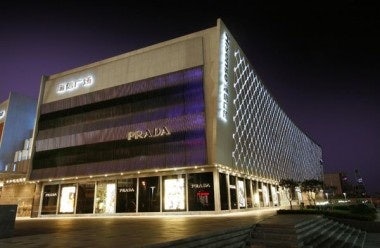Spot Investigation By Qingdao Newspaper Bandao Finds Discounts Scarce, Markups High#

Hisense Plaza in Qingdao
It's no secret that the high price of luxury goods in mainland China relative to Hong Kong, Europe or North America is a key factor driving Chinese consumers to buy these items abroad (or ask traveling friends to bring them back), shop at second-hand shops, or look for deals online via overseas vendors. Despite pleas by businesspeople like Wang Jianlin of the Dalian Wanda Group, who recently asked the Chinese government to drop its high luxury tariffs, and regardless of the strengthening of the Chinese yuan and pricing increases by European luxury brands (which have narrowed the price gap between Europe and China), an investigation this week by the Qingdao newspaper Bandao (半岛) finds that imported luxury brands are still up to 50 percent more expensive in China than they are abroad.
From Bandao (translation by Jing Daily team):
As the luxury goods epicenter of Shandong [Province], Hisense Plaza mall has many international top luxury brands. On the morning of March 24, the mall was mostly empty. This reporter first stepped up to the counter at Versace, noticing a number of black mens' bags placed in a conspicuous location. Immediately, the sales staff recommended several new items from the spring/summer 2011 collection, priced at anywhere from 5,000-7,000 yuan (US$764-1,069). One classic women's purse was priced even higher, at 18,600 yuan ($2,840). The adjoining display case was filled with men's and women's bags. "This men's bag is 5,010 yuan, and the other classic women's bag is 4,990 yuan," the salesperson said, adding that some women's bags cost more than 6,000 yuan, while the majority are priced between 4,000-7,000 yuan.
Further exploring the sales areas of many luxury brands, not one brand had a discount area. When asked, workers just recommended the newest seasonal items. When asked about the phenomenon of domestic luxury price changes, several counter staff just said bluntly, "These items really are more expensive [here] than in Hong Kong or overseas."
Counter staff at Versace said that since Versace's products are made overseas, they are subject to an import tariff of at least 10 percent, which raises their price."Products are more expensive than in Hong Kong, just as a result of the customs tariffs," a worker at Prada told me. Concerning the issue of discounts, a staff member explained that the target consumers for luxury brands are high-end shoppers, who aren't that concerned with discounts anyway. "The products we have here are all the newest collections, so currently we don't discount them," this individual told me.
Finishing up her investigation of Hisense Plaza, the reporter then goes on to cite observations by friends in Finland and the US on luxury pricing there.
How much lower are overseas prices for luxury goods price, compared to Qingdao? On March 24, I asked Du Peng (杜澎), a Qingdaonese resident of Finland, and long-time US resident Guo Jin (郭进).
"You can say that so-called luxury goods like LV bags, Gucci and so forth, are run-of-the-mill in Europe," Du Peng told me, adding that promotions are common during every major holiday, with prices often marked down 30-50 percent. "Take Gucci for example. In Europe you can find lots of bags priced at around 300 euros, while in China these same bags cost around 5,000 yuan (€538, US$764). That's about 50 percent more expensive." Continuing, Du Peng said, "The demand for luxury goods by Chinese people is becoming such a trend, naturally it's hard to discount them. In Europe, it's common to see LV bags that don't sell, so they're discounted by the time the new collections come in."
US resident Guo Jin explained, "In America, [brands like] Calvin Klein and DKNY are extremely common. For $60-100 you can buy a decent CK shirt. Last time I went to Qingdao I noticed a Gucci bag that would cost $1,500 in the US was listed at 15,000 yuan ($2,290)." Guo added, "In New York, you commonly see Chinese tourists buying luxury goods in groups. It's really spectacular."
It's commonly understood that the method used to collect fees by international purchasing agents goes like this: US market price + US domestic shipping fee + US domestic sales tax (9 percent at the highest) + purchasing agent service fee (10 percent of market price) + international shipping fee + insurance fee, with the full amount due upon delivery.
With no easy way to take advantage of the comparatively lower prices for luxury goods in places like New York aside from actually buying them there, though this risks, albeit slightly, having to pay retroactive customs taxes upon return to China, it seems that cash-strapped luxury aspirants might just have to save up a few more months to shop locally, try shopping online (though this puts them at risk of buying a counterfeit), or wait for a friend to go on an international shopping trip and hope for the best. It's no surprise, then, that most younger aspiring luxury buyers in China are eating instant noodles to save up for keychains and wallets while wealthier shoppers who don't have the ability to jet overseas take some measure of pride in paying the full price for items in places like Qingdao.